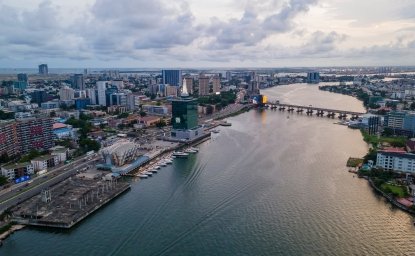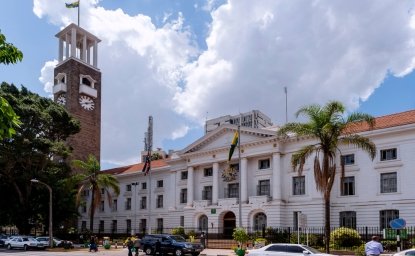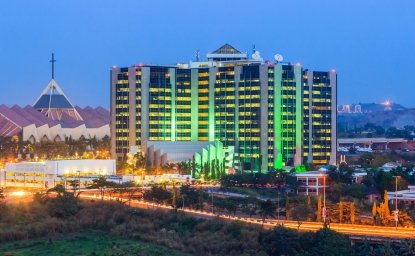
A blog of the Africa Program
Over the past 25 years, economic and political demographers have documented how declines in fertility rates have preceded improvements in state capacity, income, and political stability in much of East Asia, Latin America, and, most recently, in the Maghreb region of North Africa (Tunisia, Morocco, Algeria). Nonetheless, social scientists still debate over where and when this "demographic dividend" will occur in the youthful, low-income countries of sub-Saharan Africa. Elizabeth Leahy Madsen of the Population Reference Bureau and I find that, for most youthful countries — like those in sub-Saharan Africa — changes in population age structure provide a means to gauge the timing of their future development.
For development economists, sub-Saharan Africa's demographic payoff has already arrived. Economists envision the region's extraordinarily large proportions of young adults, adolescents, and children — 62 percent of the population is under 25 years of age — as a long-term supply of abundant labor and potential innovation, once governments implement policies that foster more open economies, greater foreign investment, and higher levels of agricultural productivity. Political scientists seem confident that more responsible political leadership, strengthened judiciaries, election reforms, anti-corruption campaigns, and a freer press will win the hearts and minds of the region's burgeoning young-adult population. Together with economists, their hopefulness has been bolstered by each new political and economic reform in the region, and by recent upticks in economic growth in some sub-Saharan states.
Yet, when presented with the very same picture, economic and political demographers are pessimistic. Why?
The Demographic Window of Opportunity
Today, about 95 percent of all countries across sub-Saharan Africa remain youthful: half or more of their population is younger than 25.5 years of age. According to the UN Population Division's current projections, nearly all of these countries are more than four decades away from entering the "demographic window" — a period that is defined by:
- low proportions of children and seniors;
- high proportions of adults in the (taxable) prime working ages of 25 to 55 years;
- workforce growth rates that have slowed to levels commensurate with job growth; and
- an average family size that is small enough for parents, as well as the state, to provide relatively high levels of per-student investment.
Without reaching this demographic window, only a handful of countries — those with substantial oil or mineral wealth, and those with small populations — have attained three of the most significant development milestones:
(1) the World Bank's upper-middle-income category;
(2) a childhood (under age five) mortality rate below 25 deaths per thousand births; and
(3) high levels (more than 80 percent) of late-secondary school enrollment.
Figure 1 shows that nearly all countries that have reached the demographic window without the assistance of migration have declined below a total fertility rate of 2.8 children per woman (Algeria and Israel declined near that level and then rose again).
Figure 1. Total fertility rate (2010-15) and median age (2015) of states in sub-Saharan Africa (SSA) and all other regions. Dotted line depicts a total fertility rate (TFR) of 2.8 children per woman. TFR has risen recently in Algeria (ALG) and Israel (ISR).
A Window in Age-Structural Time
Unlike the windows of opportunity that have emerged after the end of armed conflict, following changes in political leadership, or while windfall commodity prices brought in wealth, the demographic window is timed by a country's encounter with a series of economically and socially favorable age-structural configurations. This window was first described in a 2004 UN Population Division report accompanying its long-term projections. UN demographers estimated that the demographic window spans the period when the proportions of children and seniors (groups containing the vast majority of dependents) are both at a low ebb: when children, aged 0 to 14 years, comprise less than 30 percent of the population, and seniors, aged 65 years and older, are still under 15 percent.
Alternatively, the demographic window can be described using median age — the age of the distribution's "middle person" for whom half of the population is younger and the other half older. I converted the beginning and end of the demographic window into median ages by employing the UNPD metric and a sample of the 40 states that have entered the window since 1950 (excluding states with greater than 15 percent of GDP in oil or mineral rents). I found that, on average, the window opened when the country hit a median age of between 26 and 27 years, and typically ended between 40 and 42 years.
For most states, their trip through this window of favorable age structures is likely to be a one-time opportunity. However, the historical time spent in the window can be extended (for a while at least) by a baby boom, such as the post-war WWII rebound in fertility in the United States and in some Western European states; by an influx of youthful immigrants; or by fertility remaining near replacement levels, with very low child mortality.
Opening the Window
How far from reaching the demographic window are sub-Saharan states? Employing the UN Population Division's most recent data set, we can graph each country's median age against the change in median age over the previous five years (see Figure 2). The results cluster the sub-Saharan states into four groups. However, the first is not a group at all, but rather a single island state in the Indian Ocean, Mauritius — a small (1.3 million people), well-governed, multi-racial country that entered its demographic window in the early 1990s and is now assessed by the World Bank as an upper middle-income economy. Mauritius's demographic trajectory appears more akin to East Asia's than to any country on the African continent.
Figure 2. Four clusters of sub-Saharan African states, based upon their median age (2015) and five-year change in median age (2010-15).
The second cluster contains sub-Saharan Africa's most hopeful countries. South Africa, now at a median age of 26.2 years, is poised at the very beginning of its demographic window. The remaining three countries, which each have fewer than 5 million inhabitants, will enter the demographic window before 2025: Cabo Verde (Cape Verde), a multi-island state off the coast of West Africa, is projected to enter the window in 2018. Botswana, a well-governed mineral-rich country, will begin its journey through the window around 2021, and Djibouti, on the Red Sea coast, is scheduled to follow in 2022.
Currently, the third cluster is composed of just four states — Ethiopia, Namibia, Swaziland, and Lesotho — each projected to enter the demographic window between 2035 and 2040. Here lies some uncertainty. In the interim years, much could transpire to either delay or speed their approach. In addition, recent surveys suggest that several countries in today's fourth cluster — including Kenya and Rwanda, and perhaps a few others — could soon move into this third cluster.
According to the UNPD's medium variant scenario (which some demographers consider to be overly optimistic), none of the 39 countries in the fourth cluster — which are all located between the Tropics of Cancer and Capricorn — are projected to reach the demographic window before 2050. In fact, over the past five decades, the median ages of most of these youthful countries have hardly budged. Between 2005 and 2015 (the last decade of UNPD estimates), the median ages of Mali, Niger, Nigeria, Congo, and Uganda declined as their populations grew even more youthful; this reflects some progress in reducing childhood mortality, but very little in reducing fertility rates.
This fourth cluster includes the most youthful and fastest growing country-level populations in the world. These countries represent two-thirds (32) of the UN's current list of 47 least developed countries. They are also among the least politically stable. According to the UCDP/PRIO Conflict database, among the 42 youthful countries that reach from the Sahel through equatorial Africa, 17 (42 percent) have experienced an intra-state conflict (as defined by the database) over the past five years.
A Cup One-Eighth Full
From this demographic perspective, we see signs for both optimism and pessimism in sub-Saharan Africa. Economic and political prospects are likely to continue to brighten in the continent's southern cone (South Africa, Botswana, Namibia, Lesotho, and Swaziland) and in a few additional countries with relatively small populations (Mauritius, Cape Verde, and Djibouti). There are recent indications that several others (Ethiopia, and possibly Kenya and Rwanda) are moving more rapidly towards the demographic window than the UNPD currently projects. However, this analysis conjures a relatively bleak picture of the future for most other sub-Saharan countries, darkened by escalating conflict in the Sahel and equatorial Africa, continuing forced migration within and leaving the region, and rising political risks for the three West African states that currently score high marks in Freedom House's annual assessment: Senegal, Ghana, and Benin.
Notably, African political leaders have shown great interest in securing the demographic dividend's economic benefits. Yet, the vast majority of countries in tropical Africa remain decades away from realizing its principal effects. Amid the debate between competing development narratives, Africa's political elites may have misunderstood the timing of the demographic window, and underestimated the political effort needed to reach it.
Richard Cincotta is a global fellow at the Wilson Center and non-resident fellow at the Stimson Center.
Sources: Freedom House, The Peace Research Institute Oslo (PRIO), Performance Monitoring and Accountability 2020, United Nations Committee for Development Policy, United Nations Department of Economic and Social Affairs, World Bank
Author


Africa Program
The Africa Program works to address the most critical issues facing Africa and US-Africa relations, build mutually beneficial US-Africa relations, and enhance knowledge and understanding about Africa in the United States. The Program achieves its mission through in-depth research and analyses, public discussion, working groups, and briefings that bring together policymakers, practitioners, and subject matter experts to analyze and offer practical options for tackling key challenges in Africa and in US-Africa relations. Read more

Explore More in Africa Up Close
Browse Africa Up Close
The Innovative Landscape of African Sovereign Wealth Funds



